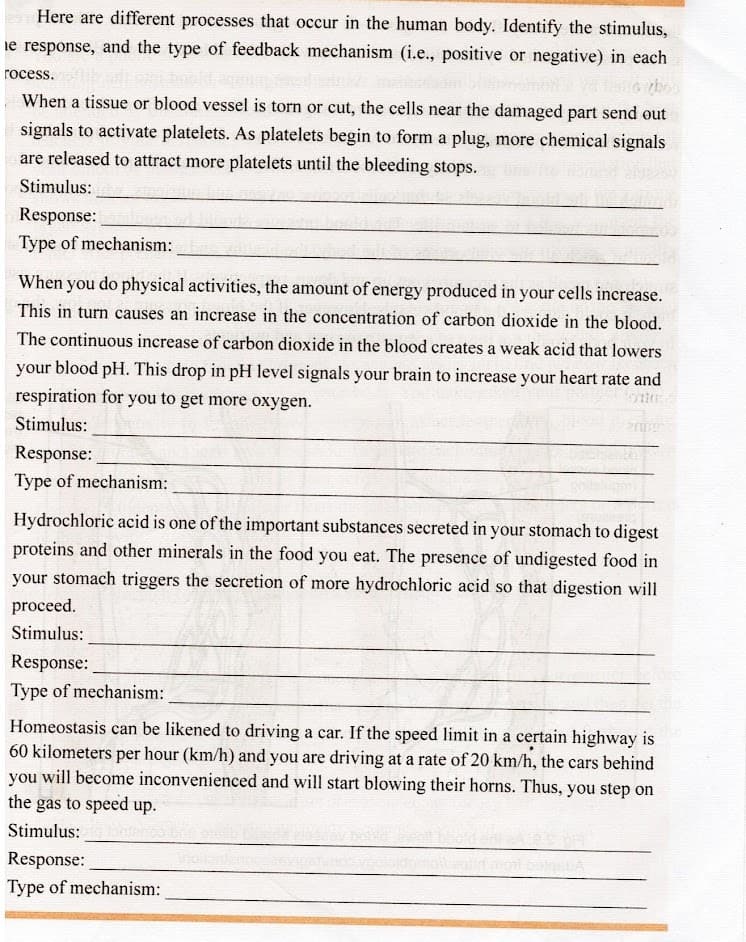When a tissue or blood vessel is torn or cut, the cells near the damaged part send out signals to activate platelets. As platelets begin to form a plug, more chemical signals are released to attract more platelets until the bleeding stops. Stimulus: Response: Type of mechanism: When you do physical activities, the amount of energy produced in your cells increase. This in turn causes an increase in the concentration of carbon dioxide in the blood. The continuous increase of carbon dioxide in the blood creates a weak acid that lowers your blood pH. This drop in pH level signals your brain to increase your heart rate and respiration for you to get more oxygen. Stimulus: Response: Type of mechanism: Hydrochloric acid is one of the important substances secreted in your stomach to digest proteins and other minerals in the food you eat. The presence of undigested food in your stomach triggers the secretion of more hydrochloric acid so that digestion will proceed. Stimulus: Response: Type of mechanism:
When a tissue or blood vessel is torn or cut, the cells near the damaged part send out signals to activate platelets. As platelets begin to form a plug, more chemical signals are released to attract more platelets until the bleeding stops. Stimulus: Response: Type of mechanism: When you do physical activities, the amount of energy produced in your cells increase. This in turn causes an increase in the concentration of carbon dioxide in the blood. The continuous increase of carbon dioxide in the blood creates a weak acid that lowers your blood pH. This drop in pH level signals your brain to increase your heart rate and respiration for you to get more oxygen. Stimulus: Response: Type of mechanism: Hydrochloric acid is one of the important substances secreted in your stomach to digest proteins and other minerals in the food you eat. The presence of undigested food in your stomach triggers the secretion of more hydrochloric acid so that digestion will proceed. Stimulus: Response: Type of mechanism:
Biology 2e
2nd Edition
ISBN:9781947172517
Author:Matthew Douglas, Jung Choi, Mary Ann Clark
Publisher:Matthew Douglas, Jung Choi, Mary Ann Clark
Chapter33: The Animal Body: Basic Form And Function
Section: Chapter Questions
Problem 2VCQ: Figure 33.21 State whether each of the following processes are regulated by a positive feedback loop...
Related questions
Question

Transcribed Image Text:Here are different processes that occur in the human body. Identify the stimulus,
ie response, and the type of feedback mechanism (i.e., positive or negative) in each
rocess.
When a tissue or blood vessel is torn or cut, the cells near the damaged part send out
signals to activate platelets. As platelets begin to form a plug, more chemical signals
are released to attract more platelets until the bleeding stops.
Stimulus:
Response:
Type of mechanism:
When you do physical activities, the amount of energy produced in your cells increase.
This in turn causes an increase in the concentration of carbon dioxide in the blood.
The continuous increase of carbon dioxide in the blood creates a weak acid that lowers
your blood pH. This drop in pH level signals your brain to increase your heart rate and
respiration for you to get more oxygen.
Stimulus:
Response:
Type of mechanism:
Hydrochloric acid is one of the important substances secreted in your stomach to digest
proteins and other minerals in the food you eat. The presence of undigested food in
your stomach triggers the secretion of more hydrochloric acid so that digestion will
proceed.
Stimulus:
Response:
Type of mechanism:
Homeostasis can be likened to driving a car. If the speed limit in a certain highway is
60 kilometers per hour (km/h) and you are driving at a rate of 20 km/h, the cars behind
you will become inconvenienced and will start blowing their horns. Thus, you step on
the gas to speed up.
Stimulus:
Response:
Type of mechanism:
Expert Solution
This question has been solved!
Explore an expertly crafted, step-by-step solution for a thorough understanding of key concepts.
This is a popular solution!
Trending now
This is a popular solution!
Step by step
Solved in 5 steps

Knowledge Booster
Learn more about
Need a deep-dive on the concept behind this application? Look no further. Learn more about this topic, biology and related others by exploring similar questions and additional content below.Recommended textbooks for you

Biology 2e
Biology
ISBN:
9781947172517
Author:
Matthew Douglas, Jung Choi, Mary Ann Clark
Publisher:
OpenStax

Biology 2e
Biology
ISBN:
9781947172517
Author:
Matthew Douglas, Jung Choi, Mary Ann Clark
Publisher:
OpenStax